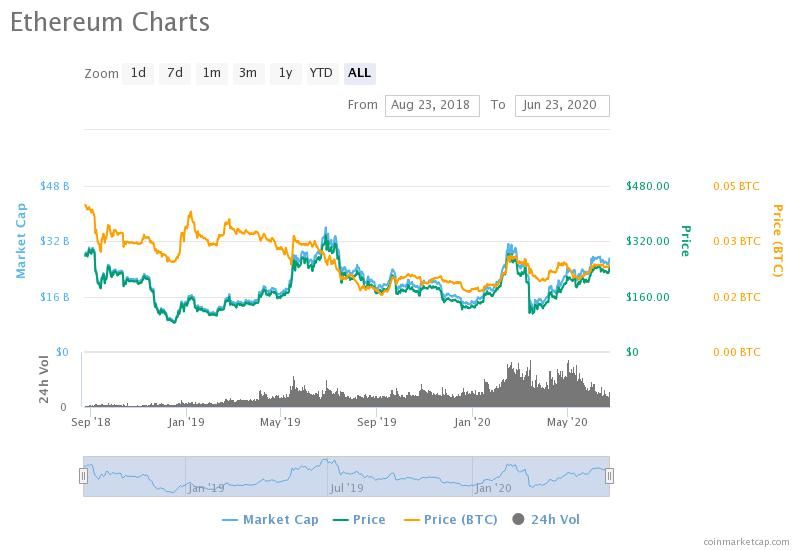Decentralized finance is the hottest thing in the crypto industry at the moment. It is largely powered by Ethereum, which has remained relatively flat in comparison. Analysts are now beginning to ask when ETH prices will start to benefit from this DeFi momentum.
Decentralized finance markets are hovering around their all-time high in terms of total value locked, which is currently just over $1.5 billion. Since the beginning of 2020, DeFi markets have grown 124% in USD equivalent TVL. Cryptocurrency markets by comparison have only managed 42% in terms of total market capitalization.
Even without the Compound Finance token distribution, which has been going on for just over a week, DeFi markets would have still outperformed crypto assets with a 45% increase year to date. Investors have realized that they can earn decent interest on their crypto holdings, while savvy traders have sought out arbitrage opportunities between different assets and protocols in this new liquidity mining craze.
SponsoredETH Lags its Way to the Moon
It stands to reason then that the biggest beneficiary from this DeFi boom should be Ethereum, but any real price momentum has yet to materialize for the world’s second-largest digital asset.
Ethereum has had a slow and steady burn this year, starting out on New Year’s Day at $130 and rising 85% to current levels around the $240 mark. However, winding the clock back to mid-2019, before DeFi really started to take off, shows that ETH prices are still down 32%.
Go back even further, and the outlook for Ethereum prices is bleak, to say the least. ETH is still 83% down from its all-time high and hasn’t really done much in terms of price over the past two years.

Prices have oscillated between lows around $120 to highs around $300, and this seems to be its problem. Ethereum has failed to break out of this range-bound channel since its epic fall from grace in early 2018. The last time ETH was truly bullish was in June 2017 when it topped $400 for the first time.
Sponsored SponsoredThe six months that followed were absolutely monumental for Ethereum, which surged to an eye-watering $1,400 during the ICO boom. Although DeFi growth has been a relatively slow burn, Ethereum has yet to benefit much in terms of price action.
Industry observer, Ryan Sean Adams, has been delving deeper into this narrative in his latest Bankless newsletter. He noted that some of the top DeFi tokens, namely COMP, AAVE, and SNX, have surged in the past week, but Ethereum has only eked out a meager 3% over the same period.
The analyst continued to add that the answer to the question can be derived from two camps—Ethereum bears and bulls.
Ethereum Bears vs Bulls
The first bearish argument would be that Ethereum is losing its ‘moneyness’ to stablecoins and other ERC-20 tokens. In 2017, Ethereum was the money used to raise funds for ICOs. In the current climate, however, it has been mostly replaced with other tokens. Adams added that bears would claim that DeFi does not necessarily correlate to higher ETH prices because it is used to make transactions:
SponsoredPeople buy the minimum amount of ETH needed to run a DeFi transaction. ETH is like gas for your car—you don’t hold it, you just keep a full tank—the minimum needed.
Finally, Ethereum bears will always claim that the network will be surpassed by something more cost-efficient, and with superior tech. Today’s gas fees are unsustainable and the scalability concerns are painfully obvious, though a real ‘Ethereum killer’ has yet to emerge.
The bullish arguments are a little more pragmatic and involve a lot more patience. After all, Ethereum is still reeling from a two-year bear market, just as Bitcoin did after its first major rally. Adams asserts that the market is ‘backward-facing,’ still assuming ETH is a utility coin.
Ethereum is a reserve asset for DeFi, he added before pointing out that it is the only asset that gets scarce with DeFi use, and the market will catch on soon.
Sponsored SponsoredAs DeFi’s reserve asset ETH isn’t threatened by stablecoins or tokenized bitcoin on Ethereum. DeFi’s success is good for ETH. More economic activity increases ETH locked up as collateral and ETH as a trading pair. DeFi token profits will be cycled back into ETH. Wait and see.
He concluded stating that the bullish arguments are more likely to be accurate for three reasons. Firstly, the amount of ETH locked in DeFi has increased significantly. Since the COMP token distribution began, a further 400,000 ETH has been locked into DeFi smart contracts taking the total above 3 million.

Furthermore, Adams cited an excerpt from a fund manager that is rebalancing his portfolio to include less Bitcoin and more Ethereum. Earlier this year it was reported that over half of all Ethereum mined this year has been acquired by Grayscale Investments, which further solidifies this institutional momentum shift.
The third reason was a protocol sink thesis, which refers to DeFi protocols with the highest settlement assurances becoming the base layer for crypto banks, and possibly even commercial and nation-state banks.
A further reason to be bullish on Ethereum is the long-awaited rollout of ETH 2.0, which will herald in proof-of-stake and Layer 2 scalability solutions. The first stages of the Serenity upgrade, Phase 0 Beacon Chain, are already being tested with full 32 ETH nodes. As previously reported by BeInCrypto, on-chain metrics for Ethereum are also improving by such levels that new all-time highs are being reached.
There have been concerns among the crypto community that Compound may have just kicked off a DeFi bubble, however, these come primarily from Bitcoin maximalists and detractors of the embryonic financial landscape.
The past week’s stellar performance by a handful of DeFi tokens is not enough to label the scene a bubble. DeFi is only just beginning and its organic growth over the past couple of years is a testament to longevity, which is ultimately bullish for Ethereum in the longer term.



